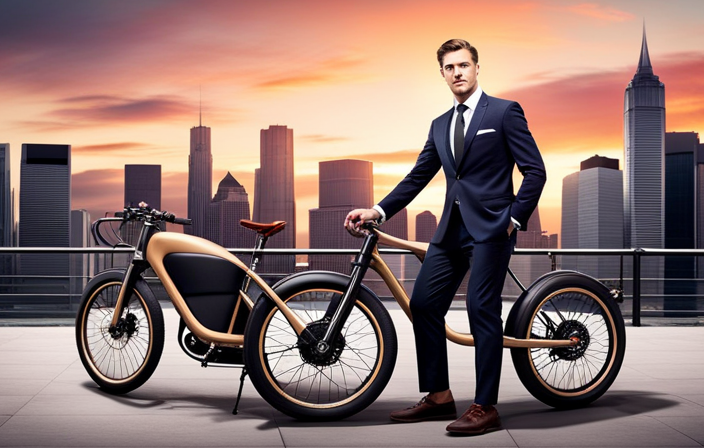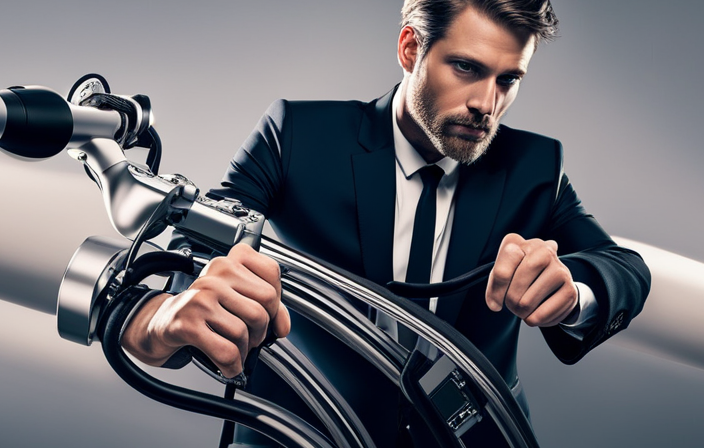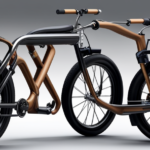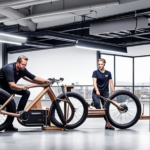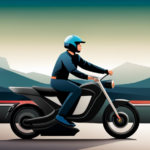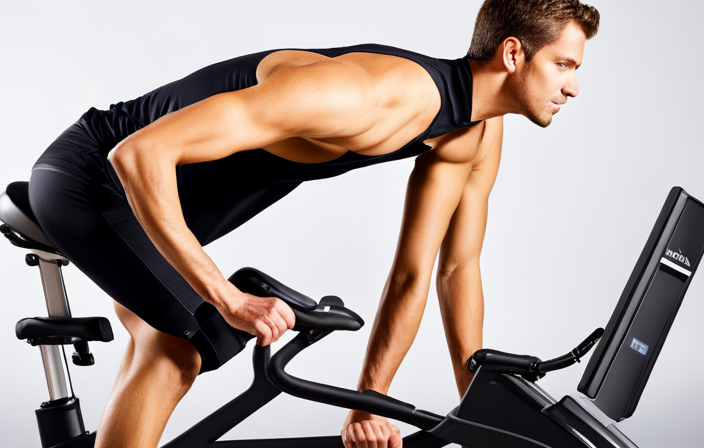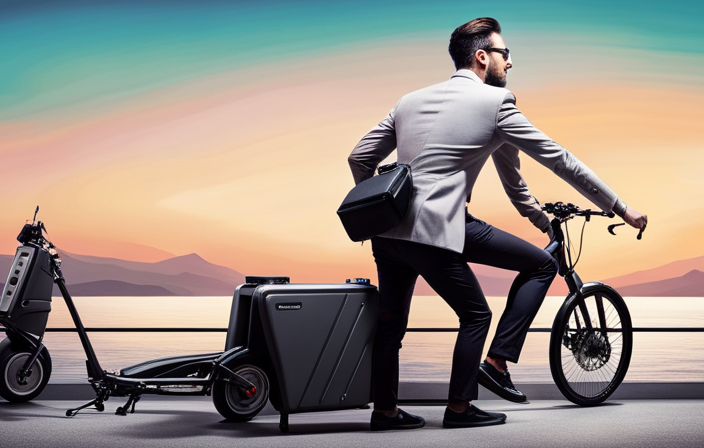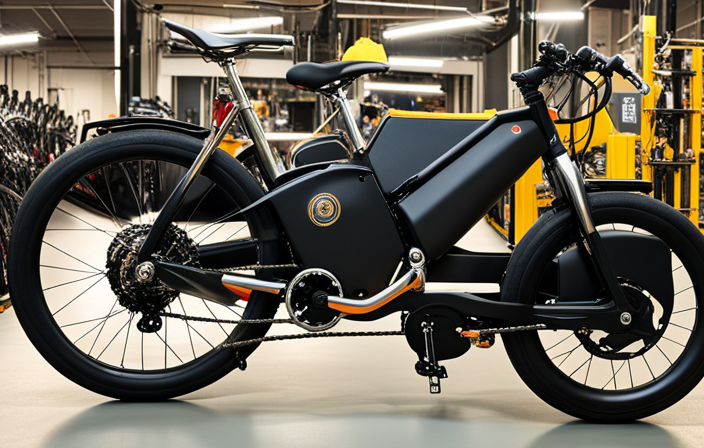You may be thinking, ‘Building my own electric bike sounds complicated and time-consuming.’ But let me assure you, with the right guidance and a little bit of patience, you can create your very own cruiser electric bike.
In this article, I will guide you through the step-by-step process of selecting the right frame, motor, and battery, gathering the necessary tools, and assembling the components. By the end, you’ll have a personalized ride that combines the joy of cycling with the convenience of electric power.
Let’s get started!
Key Takeaways
- Properly maintain and service the electric bike to ensure optimal performance and longevity
- Comply with legal requirements, such as having proper lighting and reflectors, installing a bell or horn, and adhering to speed limits
- Regularly inspect and clean electrical connections to prevent power loss
- Maximize battery life and performance by calibrating the motor controller, monitoring and maintaining battery charge level, and using efficient riding techniques like pedal-assist mode
Choosing the Right Frame for Your Electric Bike
You’ll need to choose the right frame for your electric bike. When it comes to choosing the frame material, there are several options to consider.
Aluminum is a popular choice due to its lightweight and corrosion-resistant properties. It provides a good balance between strength and cost.
Steel frames, on the other hand, offer durability and a smooth ride but can be heavier.
Carbon fiber frames are lightweight and provide excellent vibration dampening, but they tend to be more expensive.
Another important aspect to consider is customizing the frame design. This allows you to personalize your electric bike to suit your preferences and needs. Whether it’s adjusting the frame geometry or adding extra mounting points for accessories, customizing the frame design ensures that your electric bike is tailored to your specific requirements.
Selecting the Right Motor and Battery
When selecting the right motor and battery for your cruiser electric bike, it’s important to consider factors such as power output and battery range. The motor specifications determine the performance of your bike, including its top speed and acceleration. Look for a motor with sufficient power to handle your desired riding style and terrain. Additionally, check the battery capacity to ensure it can provide enough energy for your desired distance. A higher capacity battery will allow for longer rides without needing to recharge. To help you in your decision-making process, here is a table comparing the specifications of different motors and batteries:
| Motor Specifications | Battery Capacity |
|---|---|
| 500W | 10Ah |
| 750W | 15Ah |
| 1000W | 20Ah |
| 1500W | 25Ah |
| 2000W | 30Ah |
Consider these options carefully to find the perfect motor and battery combination for your cruiser electric bike.
Gathering the Necessary Tools and Equipment
Before starting the project, make sure to gather all the tools and equipment you’ll need. Here are the essential items you should have on hand:
-
Wrench set: This will allow you to tighten bolts and screws securely, ensuring the various components of the electric bike are properly attached.
-
Wire cutters and strippers: These tools will be necessary for handling the electrical wiring of the bike, ensuring a clean and efficient connection.
-
Multimeter: This device will help you test the voltage and continuity of different electrical components, ensuring they are functioning correctly.
When assembling your cruiser electric bike, it is crucial to follow safety precautions. Always wear protective gear like gloves and safety goggles to prevent injuries. Additionally, make sure to work in a well-ventilated area and avoid contact with live wires.
By selecting appropriate tools and taking necessary safety precautions, you can assemble your cruiser electric bike efficiently and safely.
Assembling the Frame and Installing Components
To assemble the frame and install components, start by attaching the frame pieces together securely. Begin by aligning the frame tubes and using a wrench to tighten the bolts firmly. Ensure that all connections are tight to guarantee stability and safety while riding.
Once the frame is assembled, move on to installing the brakes. Place the brake calipers onto the designated mounting points on the frame and secure them with bolts. Adjust the brake pads so that they make even contact with the brake rotor when engaged.
Next, focus on the gear system. Install the derailleur onto the rear dropout and adjust the cable tension to ensure smooth shifting. Fine-tune the gear indexing by turning the barrel adjuster until the gears shift seamlessly.
With these steps completed, the frame is assembled and the essential components are installed, setting the foundation for a functional cruiser electric bike.
Wiring and Connecting the Electrical System
Once the frame is assembled and the components are installed, it’s time to wire and connect the electrical system.
Proper wiring techniques and electrical connections are crucial for the smooth functioning of the cruiser electric bike.
Start by identifying the main power source and ensure it is in the off position. Use high-quality wires that are suitable for the current requirements of the electrical system.
Carefully route the wiring harness, avoiding any potential areas of abrasion or heat. Connect the positive and negative terminals of the battery to the corresponding terminals on the controller.
Double-check all connections to ensure they are tight and secure. It is essential to follow the wiring diagram provided by the manufacturer to ensure correct connections.
After completing the electrical connections, test the system to ensure proper functionality before proceeding to the next step of the electric bike assembly process.
Testing and Troubleshooting Your Electric Bike
Now that we have completed the wiring and connecting of the electrical system, it is time to move on to the next crucial step: testing and troubleshooting your electric bike. This is a crucial process to ensure that all components are functioning optimally before taking your cruiser electric bike for a spin.
To effectively troubleshoot your electric bike, follow these steps:
-
Troubleshooting the Battery:
- Check the battery connections for any loose or damaged wires.
- Measure the voltage output of the battery using a multimeter.
- Inspect the battery for signs of physical damage or leakage.
-
Troubleshooting the Motor:
- Ensure that the motor is securely mounted to the bike frame.
- Check the motor connections for any loose or disconnected wires.
- Test the motor by engaging it and observing its performance.
By diligently troubleshooting these key components, you can identify and resolve any potential issues, ensuring a smooth and enjoyable ride on your cruiser electric bike.
Adding Accessories and Personalizing Your Ride
To personalize your ride, you can add accessories to make your electric bike unique to your style and needs. There are numerous customizing options available that can enhance both the aesthetics and functionality of your cruiser electric bike.
One popular option is to install a custom seat, which not only adds a touch of personal style but also provides added comfort during long rides. Another comfort upgrade is the addition of ergonomic handlebars, which can reduce strain on your wrists and improve overall riding experience.
Additionally, you can consider adding fenders to protect yourself from mud and water splashes while riding. Other accessories to consider include a bike rack for carrying items or a front basket for added convenience.
By carefully selecting and incorporating these accessories, you can create a truly personalized and comfortable riding experience on your electric bike.
Ensuring Safety and Compliance with Regulations
Ensuring safety and complying with regulations is essential when personalizing your electric bike with accessories.
Safety standards should be followed to ensure the safe operation of your cruiser electric bike. It is important to check the safety ratings and certifications of any accessories you plan to add, such as lights, mirrors, or baskets. These accessories should meet the necessary safety standards to ensure they are durable and reliable.
Additionally, legal requirements must be met to ensure compliance with local regulations. This includes having proper lighting and reflectors, a bell or horn, and complying with speed limits. It is important to research and understand the specific legal requirements for electric bikes in your area to avoid any fines or penalties.
By prioritizing safety and complying with regulations, you can enjoy a personalized and safe riding experience.
Maintaining and Servicing Your Electric Bike
Make sure you regularly maintain and service your e-bike to keep it in optimal condition. Electric bike maintenance is crucial for ensuring its longevity and performance.
Here are some key servicing tips to follow.
Firstly, keep your battery charged within the recommended voltage range to avoid any potential damage.
Clean the bike regularly, especially after riding in dusty or muddy conditions, to prevent any dirt buildup that could affect its components.
Check the tire pressure regularly and adjust it according to the manufacturer’s recommendations for a smooth and safe ride.
Inspect the brakes and adjust them if necessary to ensure proper stopping power.
Additionally, lubricate the chain regularly to reduce friction and extend its lifespan.
Finally, it’s advisable to have your e-bike serviced by a professional technician at least once a year to address any potential issues before they become major problems.
By following these electric bike maintenance and servicing tips, you can enjoy a reliable and efficient ride for years to come.
Enjoying the Benefits of Your DIY Cruiser Electric Bike
Now that we have covered the essential aspects of maintaining and servicing your electric bike, let’s delve into the exciting part – enjoying the benefits of your DIY cruiser electric bike.
As the proud owner of a homemade electric bike, you have the opportunity to maximize its performance and extend its battery life. To achieve this, there are a few key considerations to keep in mind.
First, ensure that you properly calibrate your bike’s motor controller to match your riding style and terrain. This will optimize power delivery and efficiency.
Second, regularly monitor and maintain your battery’s charge level, avoiding both complete discharge and overcharging. Additionally, implementing efficient riding techniques, such as using pedal-assist mode when possible, can significantly improve battery life.
Lastly, regularly inspect and clean all electrical connections to prevent any potential power loss.
By following these guidelines, you can fully enjoy the benefits of your cruiser electric bike while maximizing its performance and extending its battery life.
- Regularly calibrate the motor controller
- Monitor and maintain battery charge level
- Implement efficient riding techniques
- Inspect and clean electrical connections
Frequently Asked Questions
Can I modify a regular bicycle frame to make it suitable for an electric bike conversion?
Yes, a regular bicycle frame can be modified for an electric bike conversion. This process involves adding components such as a motor, battery, and controller. Converting a regular bike offers benefits such as increased speed, range, and the ability to tackle hilly terrain effortlessly.
How do I choose the right size battery for my electric bike?
When choosing the right battery for an electric bike conversion, several factors come into play. Consider battery types such as lithium-ion or lead-acid, weighing the pros and cons of each to make an informed decision.
Is it possible to install a regenerative braking system on my electric bike?
Installing a regenerative braking system on an electric bike offers several benefits, such as increased range and improved overall efficiency. However, challenges and limitations include cost, complexity of installation, and limited effectiveness at low speeds.
What is the average range that I can expect from my electric bike on a single charge?
On a single charge, the average range for an electric bike can vary depending on several factors, including battery capacity, terrain, rider weight, and riding style. Comparing electric bike ranges can help determine the suitable option for you.
Can I use a hub motor instead of a mid-drive motor for my electric bike conversion?
When considering a hub motor for an electric bike conversion, factors to consider include simplicity, cost, and ease of installation. Pros include a quieter ride and better weight distribution, while cons include reduced torque and limited gear options compared to mid-drive motors.
Conclusion
In conclusion, building my own cruiser electric bike has been a rewarding endeavor. I have carefully selected the frame, motor, and battery, ensuring optimal performance.
With the right tools and equipment, I have successfully assembled the bike, connecting the electrical system with precision.
By adding accessories and personalizing my ride, I have made it truly unique. Safety and compliance with regulations have been paramount, and regular maintenance will ensure longevity.
Now, as I cruise down the road, I feel a sense of liberation, like a bird soaring through the sky.
